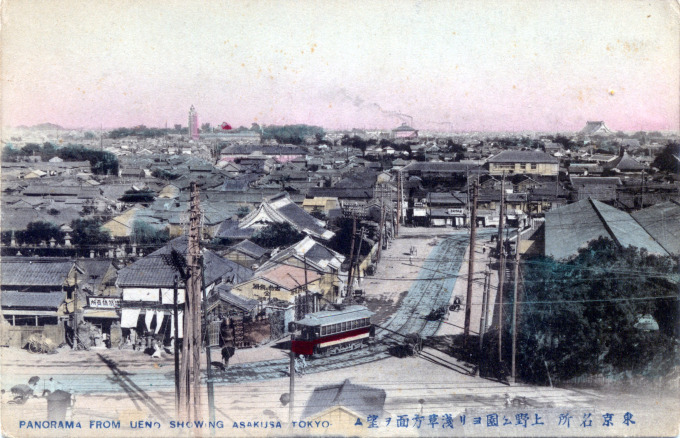
Panoramic view of Ryounkaku (Twelve-Storeys Tower) rising above Asakusa Park and the red roof of the Asakusa Kannon (Senso-ji), as seen from Ueno Station, c. 1910.
See also:
Asakusa Rokku (Theater Street), c. 1910-1950.
Asakusa Park, c. 1910.
Temple of the Goddess of Mercy, Asakusa Kannon, c. 1910.
“In an unfinished novel, The Mermaid (Koujin), Tanizaki tells what Asakusa was like in 1918. Its attractions were ‘plays of the old style, operettas, plays in the new style, comedies, movies – movies from the West and Japanese productions, Douglas Fairbanks and Onoe Matsunosuke – acrobats balancing on balls, bareback riders, Naniwa bushi singers, girl gidayu chanters, the merry-go-round, the Hanayashiki Amusement Park, the Twelve Story Tower, shooting galleries, whores, Japanese restaurants, Chinese restaurants, and Western restaurants – the Rairaiken, won ton mein, oysters over rice, horsemeat, snapping turtles, eels, and Café Paulista.’
“… Crudity became an Asakusa commodity. The hero of Tanazaki’s novel is simultaneously repelled and attracted by it. He confides that he is drawn to Asakusa because, finding Tokyo ugly, he wants to ‘experience this ugliness in its purest state’ … This crude and ugly but vibrant and sexy Asakusa was soon after destroyed.
“The 1923 Kanto earthquake demolished it, as it demolished much of Tokyo and Yokohama. Among the more famed calamities was the collapse of the Asakusa Twelve Story Tower (the Ryounkaku, or ‘Cloud Surpassing Pavilion’), a brick structure that had become synonymous with Asakusa. Also gone was the old neighborhood structure of the place. The sense of community, raffish but real, that had appealed to many was never fully recovered.”
– The Scarlet Gang of Asakusa, from the forward by Donald Richie, 2005



Pingback: Kaminarimon, Asakusa, c. 1910. | Old Tokyo